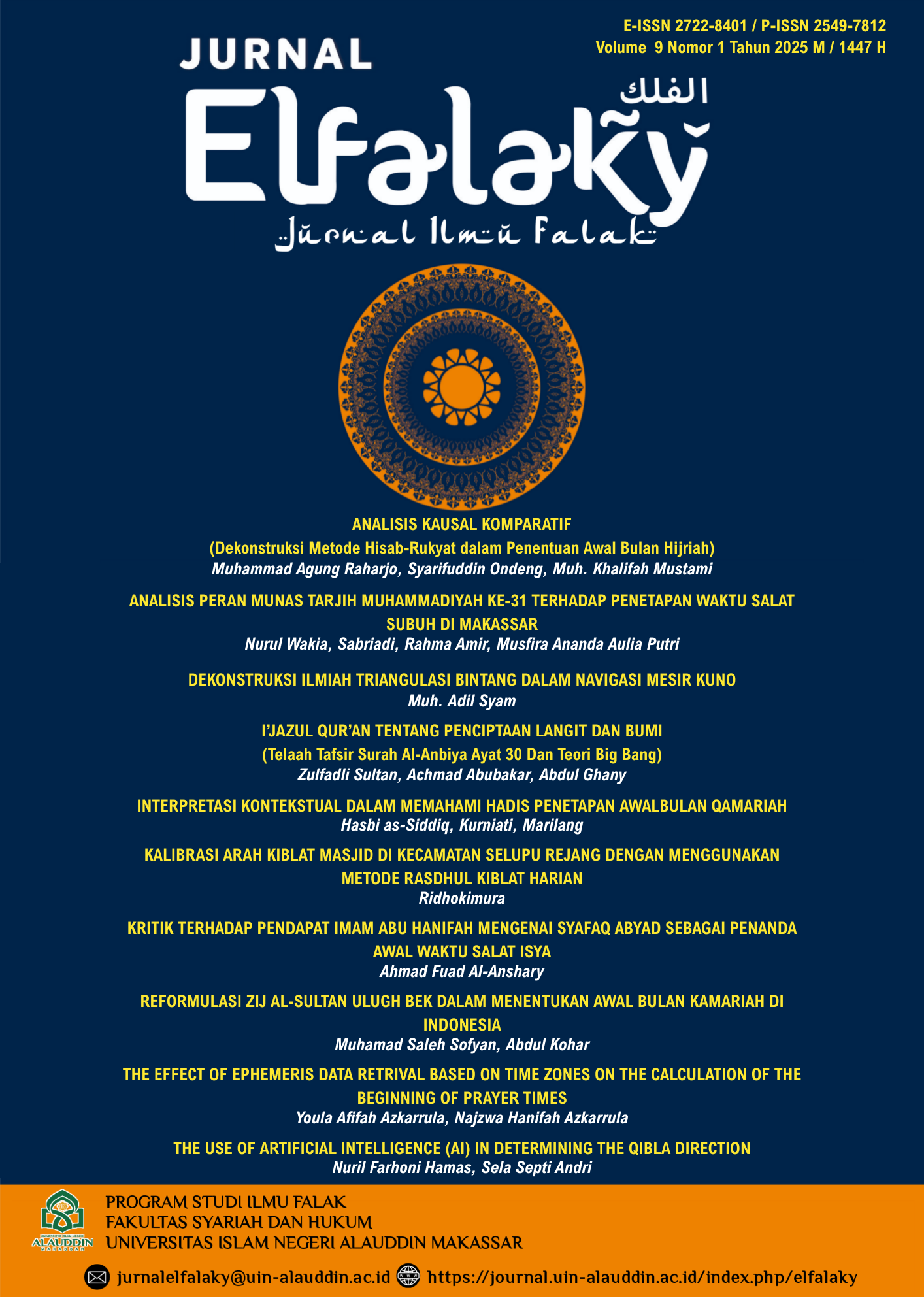I’JAZUL QUR’AN TENTANG PENCIPTAAN LANGIT DAN BUMI (Telaah Tafsir Surah Al-Anbiya Ayat 30 Dan Teori Big Bang)
DOI:
https://doi.org/10.24252/ifk.v9i1.57079Keywords:
I'jaz al-Qur'an, Big Bang theory, QS. al-Anbiya verse 30, Tafsir Al-AzharAbstract
This paper examines the miracle (i’jaz) of the Qur'an in the context of the creation of the
heavens and the earth, focusing on the interpretation of Surah Al-Anbiya Verse 30 and
its relevance to the Big Bang theory. This study aims to show the harmony between the
teachings of the Qur'an and modern scientific discoveries. The method used is a
qualitative method with a text analysis approach and literature review, the interpretations
used as references include the Tafsir Al-Azhar by Buya Hamka. The results of this study
reveal that the Big Bang Theory is in line with the explanation contained in QS. al-Anbiya'
[21]: 30. In this verse, it is explained that the process of the creation of the earth began
with the heavens and the earth uniting, then Allah separated the two. Meanwhile, in the
Big Bang theory, the creation of the universe began with an explosion that produced
matter, energy, planets, and various other elements. Although there are differences in the
method of delivery, both the Qur'an and the Big Bang theory provide a deep
understanding of the origins of the universe.
References
Abd Dahlan, Rahman. “Kaidah-Kaidah Tafsir.” Jakarta: Amzah, 2014.
Ayat, Penafsiran M Quraish Shihab Terhadap. “Penafsiran M. Quraish Shihab Terhadap Ayat-Ayat Tentang Penciptaan Alam Semesta,” 2008.
Aziz, Abdul. Bumi Sholat Secara Matematis. UIN-Maliki Press, 2007.
Dartoyo, Ari, Dewi Susiloningtyas, and Ikhzan Pambudi. “Editor Ensiklopedi Sains Dan Teknologi Jilid I (Alam Semesta Bumi Masa Prasejarah).” PT. Lentera Abadi, Jakarta, 2008.
Fikri, Muslim, and Elya Munfarida. “Konstruksi Berpikir Kritis Dalam Pendidikan Islam : Analisis Tafsir Maudhu ’ i Berdasarkan Al- Qur ’ an.” Jurnal Pendidikan Agama Islam: Al-Thariqah 8, no. 1 (2023): 108–20. https://doi.org/10.25299/al-thariqah.2023.vol8(1).11469.
Hartono, Geografi. “Jelajah Bumi Dan Alam Semesta.” Bandung: Penerbit Citra Praya, 2007.
malik karim Amrullah, Abdul. “Tafsir Al-Azhar Jilid 6.” Pustaka Nasional PTE LTD, 1990, 4562.
NASA. “The Telescope That Captured Our Imaginations,” n.d. https://science.nasa.gov/mission/hubble/observatory/.
Rahmawati, Syafitri. “Ketika Planet Ditemukan.” Bandung: Cv. Amanah, 2013.
Ristasa, Rusna. “Sejarah Perkembangan Teori Evolusi Makhluk Hidup.” Jurnal Repository. Ut. Ac. Id./4251/1/PEBI4204/Modul 1 (2015).
Sani, Ridwan Abdullah. Sains Berbasis Alquran Edisi Kedua. Bumi Aksara, 2022.
Santoso, Dwi Agus. “Buku Pintar Ruang Angkasa.” Gunung Sahari: Galaksi Aksara Media, 2014.
Septina, Atika, Muyasaroh Muyasaroh, Dwi Noviani, and Destri Wulandari. “Al-Qur’an Dan Urgensinya Dalam Kehidupan Manusia.” Ta’rim: Jurnal Pendidikan Dan Anak Usia Dini 4, no. 3 (2023): 127–35. https://doi.org/10.59059/tarim.v4i3.211.
Shihab, M Quraish. “Tafsir Al-Misbah.” Jakarta: Lentera Hati 2 (2002): 40–41.
Yusuf, Muhammad, Hamzah Harun al-Rasyid, and Muhaemin Latif. “Konsep Emanasi Filsuf Islam Dan Hubungannya Dengan Teori Sains Mengenai Penciptaan Alam Semesta.” Jurnal Alwatzikhoebillah: Kajian Islam, Pendidikan, Ekonomi, Humaniora 10, no. 2 (2024): 501–9.









